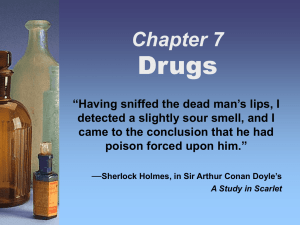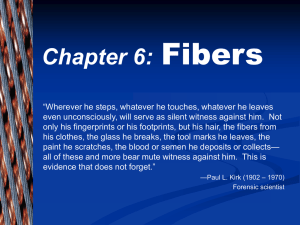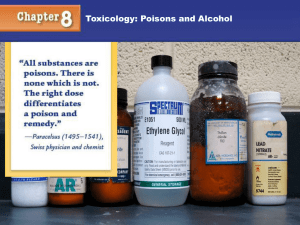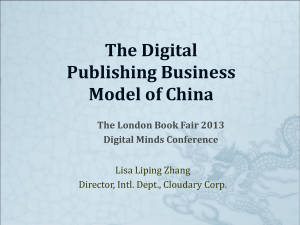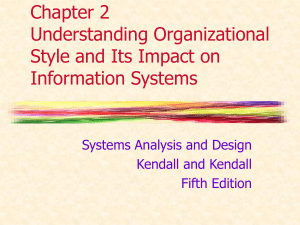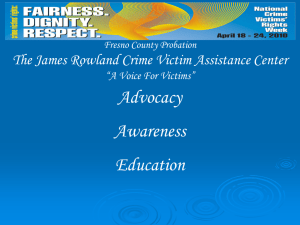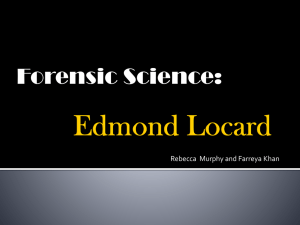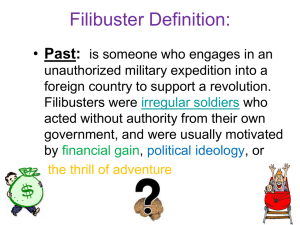Introduction to Forensic Science and the Law
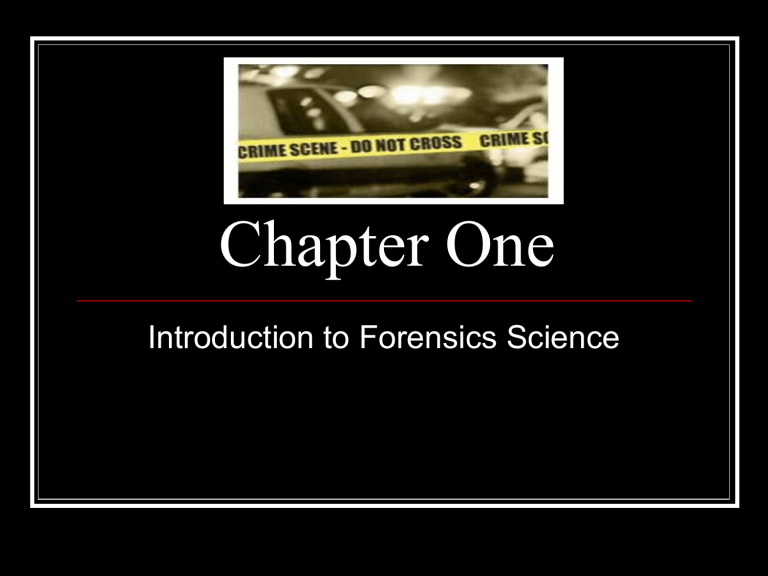
Chapter One
Introduction to Forensics Science
Forensic Science and the Law
“In school, every period ends with a bell. Every sentence ends with a period. Every crime ends with a sentence.”
—Stephen Wright, comedian
A. Forensic Science
A study and application of science to law provide accurate, thorough info to decision makers in our criminal justice system.
Comes from Latin “forensis” = forum, a public place where, in Roman times, senators and others debated and held judicial proceedings.
Video
Kendall/Hunt Publishing Company Chapter 1 2
Criminalistics vs Criminology
Criminalistics
the scientific examination of physical evidence for legal purposes.
Criminology
includes the psychological angle, studying the crime scene for motive, traits, and behavior that will help to interpret the evidence
Kendall/Hunt Publishing Company Chapter 1 3
Crime Lab —Basic Services
Physical Science Unit
Chemistry
Physics
Geology
Biology Unit
Anything that deals with the human body
Firearms Unit (Ballistics)
Document Examination
Unit
Photography Unit
Kendall/Hunt Publishing Company Chapter 1 4
Crime Lab —Optional Services
Toxicology Unit- poisons
Latent Fingerprint Unit- hidden
Polygraph Unit
Voiceprint Analysis Unit
Evidence Collection Unit
Kendall/Hunt Publishing Company Chapter 1 5
Other Forensic Science Services
Forensic Pathology- diseases
Forensic Anthropology- bodies
Forensic Entomology- bugs
Forensic Psychiatry- the mind
Forensic Odontology- teeth
Forensic Engineering- structures
Cybertechnology - computers
Kendall/Hunt Publishing Company Chapter 1 6
Chapter 1
Major Crime Laboratories
FBI- Federal Bureau of Investigation
DEA- Drug Enforcement Agency
ATF- Bureaus of Alcohol, Tobacco, and
Firearms
U.S. Postal Service
U.S. Fish and Wildlife Service
Kendall/Hunt Publishing Company 7
Crime Lab History
Arthur Conan Doyle write Sherlock Holmes
VideoThe Great Mouse Detective
Sherlock Holmes (2009)
First crime lab in the world - France in 1910 by Edmond Locard
First crime lab in U.S. - 1923 in Los Angeles
The Scientific Crime Detection Lab was founded in 1929 as a result of the St. Valentine’s Day Massacre
The first FBI crime lab opened in 1932 with the help of Dr. Calvin
Goddard
Video
Kendall/Hunt Publishing Company 8 Chapter 1
Major Developments in Forensic Science History
700s AD
—Chinese used fingerprints to establish identity of documents and clay sculptures
~1000 —Roman courts determined that bloody palm prints were used to frame a man in his brother’s murder
1149
—King Richard of England introduced the idea of the coroner to investigate questionable death
1200s
—A murder in China is solved when flies were attracted to invisible blood residue on a sword of a man in the community
1598 —Fidelus was first to practice forensic medicine in Italy
1670
—Anton Van Leeuwenhoek constructed the first high-powered microscope
1776
—Paul Revere identified the body of General Joseph Warren based on the false teeth he had made for him
1784 —John Toms convicted of murder on basis of torn edge of wad of paper in pistol matching a piece of paper in his pocket
1840- Mathew Orfila helps convict a criminal of poisoning
Kendall/Hunt Publishing Company Chapter 1 9
Major Developments in Forensic
Science History
1859
—Gustav Kirchhoff and Robert Bunsen developed the science of spectroscopy.
1864
—Crime scene photography developed
1879
—Alphonse Bertillon developed a system to identify people using particular body measurements
1892Francis Galton ID’s fingerprint categories
1896 —Edward Henry developed first classification system for fingerprint identification
1900 —Karl Landsteiner identified human blood groups
1904
—Edmond Locard formulated his famous principle, “Every contact leaves a trace.”
1910- Locard develops the first crime lab
1922
—Francis Aston developed the mass spectrometer.
1959 —James Watson and Francis Crick discover the DNA double helix
1977 —AFIS developed by FBI, fully automated in 1996
1984
—Jeffreys developed and used first DNA tests to be applied to a criminal case
Turn to pages 4,5,6
Kendall/Hunt Publishing Company 10 Chapter 1
People of Historical Significance
Edmond Locard (1877-1966)
French professor and police officer
Considered the father of criminalistics
Built the world’s first forensic laboratory in France in 1910
Locard Exchange Principle
Whenever two objects come into contact with each other, traces of each are exchanged.
Kendall/Hunt Publishing Company 11 Chapter 1
Locard in Action
Pretend you have two children and a cat.
You run out to take care of some errands that include stopping at a furniture store, the laundry and the house of a friend who has one child and a dog. What are some things you could leave behind at each stop? What are some things you might collect? Discuss…
Kendall/Hunt Publishing Company Chapter 1 12
In many cases, the mere fact that a suspect can be placed at the scene is an indication of guilt. Examples?
Fingerprints
Semen obtained from a rape kit
Paint from the fender of a car
Kendall/Hunt Publishing Company 13 Chapter 1
B. The Titles
Criminalist: Those who deal with the forensic evidence
Not cops!
Don’t carry guns, don’t interrogate suspects or make arrests
Don’t treat the injured or dead
They just collect evidence. That’s it!
Forensic Investigator: Those who deal with the body (if there is one)
Video
Kendall/Hunt Publishing Company Chapter 1 14
Common Jobs for a Criminalist
CSI: collect, protect, transport evidence, document and sketch, photograph
Print examiner: specialize in fingerprints
Firearms examiner: examining and identifying firearms, bullets, shell casings and GSR
Toolmark examiner: it is what it is…
Document examiner
Trace evidence examiner: analyze and compare hair, figbers, glass, soils and paints
Kendall/Hunt Publishing Company 15 Chapter 1
Common Jobs for a Forensic
Investigator
Pathologist: physician with specialty training in diseases; in charge of body and evidence on it
Anthropologist: human skeletal remains to determine age, sex and race of body and establish TOD; toxicology, too
Odontologist: id’s unknown corpses by matching dental records
Entomologist: uses life cycles of flies and insects that feed on corpses to determine the approximate time of death, also determine whether a body has been moved
Psychiatrist: address sanity, give medical advice
Serologist: deals with blood and bodily fluids
Toxicologist: study of drugs and poisons (DWIs, etc)
Botanist: examines plant residues to help solve a crime
Kendall/Hunt Publishing Company 16 Chapter 1
Coroner Vs. Medical Examiner
Coroner: appointed or elected position that requires no special medical skills; it’s a political position; some are doctors
Medical Examiner: physician, licensed to practice medicine and trained in pathology
Kendall/Hunt Publishing Company 17 Chapter 1
C. US Laws
The U.S. Constitution
Statutory Law
Common Law or Case Law
Civil Law
Criminal Law
Equity Law
Administrative Law
Kendall/Hunt Publishing Company Chapter 1 18
Laws
1.
2.
3.
4.
Constitution- governs our country
Statutory Laws“law on the books”; based on the constitution, made by govn’t
Common Law- made by judges; application of the law
Civil Law- relationships between individuals, assign blame: marriage, property, contracts
Kendall/Hunt Publishing Company 19 Chapter 1
Laws…
5.
Criminal Law- enforcement of rights; offensive to society; the state becomes the plaintiff – person offended
Example: The People Vs. Larry Flint
Example: The State of Wisconsin Vs. Yoder
Misdemeanor- minor crime: theft, small amt of drugs
Felony- major crime: murder, rape, armed robbery, drugs
Jail time
6.
Equity Law- preventive: restraining order
7.
Administrative Lawrules established by gov’t agencies: taxes, social security, military
Kendall/Hunt Publishing Company 20 Chapter 1
The Bill of Rights
The first 10 amendments to the
Constitution
Developed shortly after the constitution because of the memory of loss of civil rights in England
Bill of Rights
Most famous:
Right to free speech
Right to assemble peacefully
Right to bear arms
Kendall/Hunt Publishing Company 21 Chapter 1
Bill of Rights and FS-
Assures an individual’s right:
To be presumed innocent until proven guilty
Not to be searched unreasonably
Not to be arrested without probable cause
Against unreasonable seizure of personal property
Against self-incrimination
To fair questioning by police
To protection from physical harm throughout the justice process
To an attorney
To trial by jury
To know any charges against oneself
To cross-examine prosecution witnesses
To speak and present witnesses
Not to be tried again for the same crime
Against cruel and unusual punishment
To due process
To a speedy trial
Against excessive bail
Against excessive fines
To be treated the same as others, regardless of race, gender, religious preference, country of origin, and other personal attributes
Kendall/Hunt Publishing Company 22 Chapter 1
Steps to Justice
1.
2.
3.
4.
5.
6.
Crime committed, discovered
Police investigate
ID suspect
Crime scene documented
Info is given to prosecutor
Investigation
Probable cause-arrest warrant (situation concluding that a crime was committed by the suspect)
Kendall/Hunt Publishing Company 23 Chapter 1
Miranda v Arizona
In 1963, Ernesto Miranda, a 23 year old mentally disturbed man, was accused of kidnapping and raping an 18-year-old woman in Phoenix, Arizona.
He was brought in for questioning, and confessed to the crime. He was not told that he did not have to speak or that he could have a lawyer present.
At trial, Miranda's lawyer tried to get the confession thrown out, but the motion was denied.
The case went to the Supreme Court in 1966. The
Court ruled that the statements made to the police could not be used as evidence, since Mr. Miranda had not been advised of his rights.
Kendall/Hunt Publishing Company 24 Chapter 1
Miranda Rights
The following is a minimal Miranda warning:
You have the right to remain silent. Anything you say can and will be used against you in a court of law. You have the right to speak to an attorney, and to have an attorney present during any questioning. If you cannot afford a lawyer, one will be provided for you at the government’s expense.
Kendall/Hunt Publishing Company 25 Chapter 1
After Miranda
1.
2.
3.
3.
4.
Brought to judge
Arraignment: defendant hears charges and enters a plea- guilty, not guilty, nolo contendere (no contest)
Not admitting guilt, but doesn’t say they are innocent
Subjects them to conviction, but maybe be used in conjunction with a plea bargin
If Guilty plea - taken to court preliminary hearing, no jury, pass sentence
If Not Guilty Plea- judge decides if trial, bail
Sometimes Grad jury- big felonies; no judge, panel of judges that vote; if trial- indictement
Kendall/Hunt Publishing Company 26 Chapter 1
Types of Crimes
1.
2.
3.
Infractionless petty than a misdemeanor
Misdemeanor
Felony
Kendall/Hunt Publishing Company Chapter 1 27
Federal Rules of Evidence
In order for evidence to be admissible, it must be:
Probative —actually prove something
Material —address an issue that is relevant to the particular crime
Hearsay is not admissible because it is not reliable
Kendall/Hunt Publishing Company Chapter 1 28
Testimony
Expert Witness
Frye Standard: Applies to new science, states: evidence is admissible if the method which it was obtained is based on acceptance from the scientific community
Daubert Ruling: Revision of the Frye Standard, evidence must follow the scientific method
Changing technology; lots of junk science
(theories based on untested hypothesis)
Kendall/Hunt Publishing Company 29 Chapter 1
Facets of Guilt
Try to prove:
Means —person had the ability to do the crime
Motive —person had a reason to do the crime
(not necessary to prove in a court of law)
Opportunity —person can be placed at the crime
Kendall/Hunt Publishing Company Chapter 1 30
“If the Law has made you a witness, remain a man (woman) of science.
You have no victim to avenge, no guilty or innocent person to ruin or save.
You must bear testimony within the limits of science.”
—P.C.H. Brouardel
Kendall/Hunt Publishing Company Chapter 1 31


